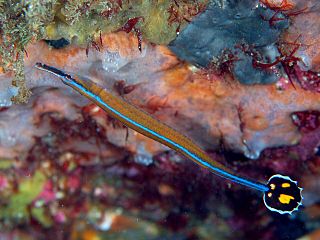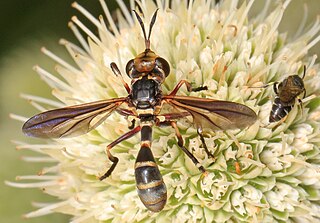
The Conopidae, usually known as the thick-headed flies, are a family of flies within the Brachycera suborder of Diptera, and the sole member of the superfamily Conopoidea. Flies of the family Conopidae are distributed worldwide in all the biogeographic realms except for the poles and many of the Pacific islands. About 800 species in 47 genera are described worldwide, about 70 of which are found in North America. The majority of conopids are black and yellow, or black and white, and often strikingly resemble wasps, bees, or flies of the family Syrphidae, themselves notable bee mimics. A conopid is most frequently found at flowers, feeding on nectar with its proboscis, which is often long.
Hyloxalus excisus is a species of frog in the family Dendrobatidae. It is endemic to Colombia. It is only known from its type locality near Medellín, Antioquia Department, on the Cordillera Central.
Chamalycaeus is a genus of tropical land snails with an operculum, terrestrial gastropod mollusks in the family Cyclophoridae.

Onthophagus is a genus of dung beetles in the Onthophagini tribe of the wider scarab beetle family, Scarabaeidae. It is the most species-rich and widespread genus in the subfamily Scarabaeinae, with a global distribution.

Doryrhamphus is a genus of pipefishes, one of the two genera colloquially known as flagtail pipefishes and are popular in the aquarium trade. The members of this genus are native to the Indian and Pacific Oceans where they inhabit reef environments. The species in this genus have a maximum length of 14 centimetres (5.5 in) or less, with D. janssi being the only species that surpasses 8.5 centimetres (3.3 in). Most species have a horizontal blue line along their body, and all have a whitish-edged tail that is marked contrastingly with black, red or yellow.
Physoconops bulbirostris is a species in the family Conopidae, in the order Diptera ("flies").

Physoconops is a genus of thick-headed flies in the family Conopidae. There are about 13 described species in Physoconops.
Physoconops brachyrhynchus is a species of thick-headed fly in the family Conopidae.
Physoconops townsendi is a species of thick-headed fly in the family Conopidae.
Physoconops obscuripennis is a species of thick-headed fly in the family Conopidae.
Physoconops fronto is a species of thick-headed fly in the family Conopidae.
Physoconops discalis is a species of thick-headed fly in the family Conopidae.
Physoconops sylvosus is a species of thick-headed fly in the family Conopidae.
Gozmanyina majestus is a species of cosmochthoniid in the family Cosmochthoniidae.
Phloeosinus pini is a species of crenulate bark beetle in the family Curculionidae. It is found in North America.
Physoconops floridanus, the Florida physoconops, is a species of thick-headed fly in the family Conopidae.
Physoconops gracilis is a species of thick-headed fly in the family Conopidae.
Physoconops nigrimanus is a species of thick-headed fly in the family Conopidae.
Physoconops analis is a species of thick-headed fly in the family Conopidae.

Septifer is a genus of saltwater clams, marine bivalve molluscs in the family Mytilidae, the mussels.





